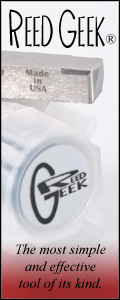Getting Started Page 2
Let’s discuss the Saxophone embouchure. Embouchure is a French word meaning “opening into.” The embouchure is your lips and facial muscles used in playing wind instruments. First you should place your two front teeth on the top of the mouthpiece about a half inch from the tip. Rest the weight of your head, or most of it, on the top of the mouthpiece. You want the mouthpiece to be anchored in the same place in your embouchure so the air stream is directed at the same place at all times. Tuck your lower lip over your lower teeth. Not too much, not too little. Don’t let your bottom teeth come in contact with the reed unless you want all the dogs in the neighborhood to start howling! You should always breathe through your mouth, keeping your top teeth on the mouthpiece. Drop your lower jaw and open your mouth and inhale quickly. By breathing this way, you can get a full breath of air in a very short period of time.
The proper articulation for the Saxophone is to start the notes with the syllable “tah.” This is critical to establish as soon as possible. You don’t actually say the word “tah,” you make that motion with your tongue. Make sure you can hear a slight “t” sound at the start of each note. Keep your tongue relaxed and in the bottom of your mouth. Try to envision what your tongue looks like as it hits the reed. Strive for the cleanest articulation you can get, no extraneous noise.
A word or two about the air stream. Breath from your diaphragm; it is the second strongest muscle in your body, so don’t be afraid to use it. 😉
One of my former teachers once had me lay on my back on the floor and he placed a large dictionary on my stomach and then sat on it. I could still breathe! I had no idea the diaphragm was that powerful. To spare you a long winded explanation (pun intended), fill up your stomach with air and focus on the tip of the reed. Imagine a bulls-eye on the tip of the reed and aim the air stream right there. A good analogy is to think of your diaphragm as if it were a rubber band. If you hold a rubber band in both hands and let it go, it just drops to the floor. If you stretch it out and let it go, it flies away, right? Your diaphragm, like the rubber band, doesn’t start working until you stretch it. Another concept to give some thought to is to think of the air stream as a string or ribbon that is constantly coming out of your mouth. Another good analogy is to think of your body as an aerosol spray can. You have the compressed air coming out of a small opening, projecting far beyond the opening. You must blow the air stream all the way through the horn. This is a very important aspect of wind instrument tone production. All the way through, out into the cosmos. For a great book that covers this subject and many other aspects of Saxophone playing, click on the title for The Art of Saxophone Playing
by Larry Teal.
Now, about your fingers. Due to the difference in Saxophone design, some Saxophones have a pearl for the top key (front F), and some do not. So, I will give the best explanation of exactly where to place your fingers. I will refer to the two “stacks” or groups of keys, the top one is the left hand. Your left thumb goes on the thumb rest (left hand is on top). Look at the stack of pearls, you will see one that is smaller that the rest. This is the bis Bb key. Your left index finger goes on the key right above the smallest pearl (bis Bb) in the left hand stack. Put your middle finger on the pearl right below the smallest pearl (bis Bb). The ring finger goes on the pearl right below the middle finger. The left thumb operates the octave key. The left pinky controls the “plate keys” i.e. low Bb, B, C# & G# keys.
Your right thumb goes under the thumb hook. The right index finger goes on the top pearl of the right hand stack, middle finger goes right beneath that, and the right ring finger goes on the bottom pearl. Your right pinky operates the low C and the Eb key. I will put up some pictures as soon as I can, although the picture of me on the first page is fairly clear. You can see the front F pearl on the top, and you can see the small pearl (bis Bb key) in between my index and middle fingers. Also, I have a fingering chart here you may want to refer to. I have added a fingering chart for the visually impaired here. Try to keep your hands and fingers as relaxed as possible and your fingers close to the keys at all times.





